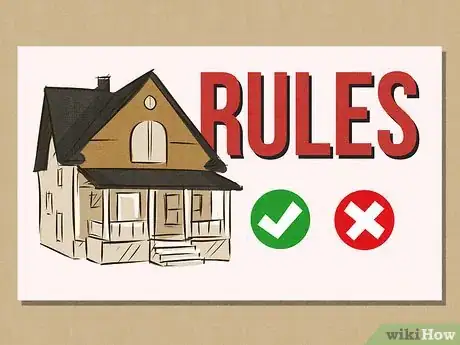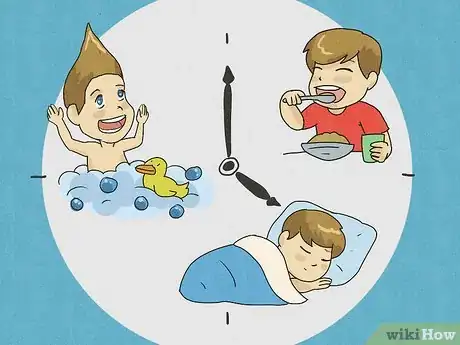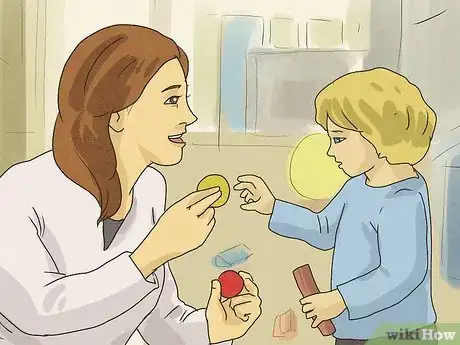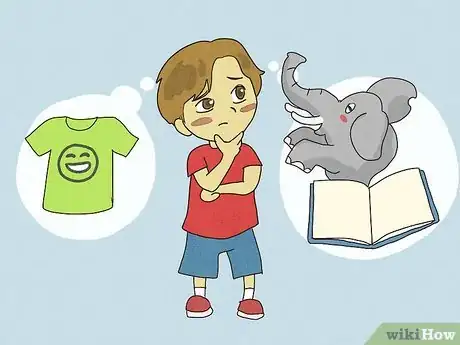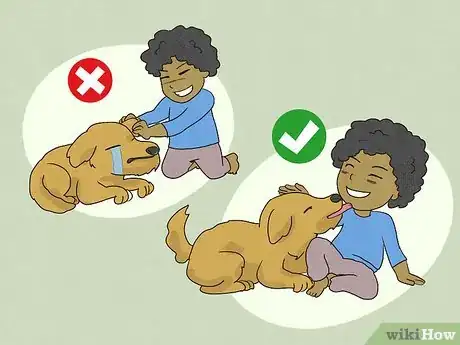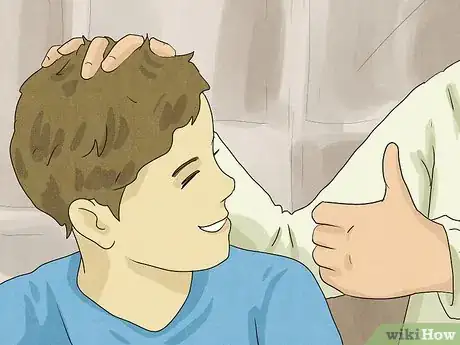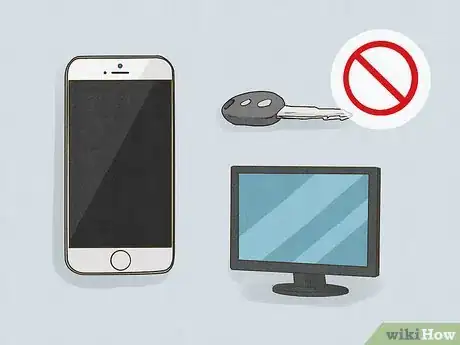This article was co-authored by Trudi Griffin, LPC, MS. Trudi Griffin is a Licensed Professional Counselor in Wisconsin specializing in Addictions and Mental Health. She provides therapy to people who struggle with addictions, mental health, and trauma in community health settings and private practice. She received her MS in Clinical Mental Health Counseling from Marquette University in 2011.
There are 14 references cited in this article, which can be found at the bottom of the page.
This article has been viewed 401,738 times.
Discipline is a way to teach your child appropriate behavior, not punish them.[1] Depending on your child’s age, you will discipline them differently. When disciplining your child, start by setting some rules that your child clearly understands. When implementing discipline, be consistent and set rules that encourage your child to succeed. Affirm when your child does something right and encourage their best behavior.
Steps
Setting Rules and Building Consistency
-
1Establish house rules. Regardless of the age of your child, it’s important that they know the difference between appropriate and inappropriate behavior. Let your child know what you expect of them by setting house rules. Your child should know what behaviors are off limits and what will happen when they break a rule.[2]
- Rules and consequences will vary by your child’s age and maturity level. A young child may need a rule not to hit, while an older child may need rules around curfew. Be willing to approach them with a degree of flexibility as your child matures or needs new boundaries.
-
2Establish a routine. Children thrive with routines as they help them feel safe, secure, and as if they can anticipate what’s to come. If you notice that your child struggles with behaviors at the same time each day or melts down when they feel tired, take note of these things and create a routine that can accommodate their needs.[3]
- Make morning and bedtime routines predictable so that your child can anticipate their day.
- If your child has a change in their routine (like a visit to the dentist or a family member visiting for the weekend), let them know well in advance.
- Some children can’t jump from one activity to another without feeling jarred. If your child needs some time to adjust, build this into their routine.
Advertisement -
3Provide natural consequences to behaviors. Allowing natural consequences to occur can help your child gain a sense of cause-and-effect and build self-responsibility. When allowing natural consequences to occur, give your child choices and let them know what the outcome will be regarding their choices. Your child ultimately will decide what happens and experience the consequences.[4]
- Make sure the consequence is appropriate and helps your child learn from their mistake.[5]
- For example, if your child takes a long time getting ready for the park, then they receive less time to play at the park.
-
4Be consistent with consequences. Many parents get in the habit of making exceptions or allowing behaviors to slide without consequences. Children need to know you will follow through on consequences and that they cannot weasel their way out. Show them that you mean business by enforcing consequences each time they act out.[6]
- Don’t be surprised if your child has an excuse or can explain away their behavior. Be clear in saying, “You broke a rule, so that means you get a consequence.”
- If you have multiple children (or children from mixed homes), it’s especially important to be consistent with each child. Otherwise, they might feel as if you’re treating them unfairly.
-
5Have realistic expectations. Setting the bar too high for your child’s behavior can lead to them feeling pressure, while setting the bar too low may lead to a bratty child or one who won’t reach their full potential. Children develop differently and may have different strengths and weaknesses. If you have older children, don’t expect your younger children to act or behave the same way.[7]
- Familiarize yourself with what developmentally appropriate behavior looks like for your child’s age group.
Disciplining a Toddler or Young Child
-
1Redirect their attention. Toddlers (ages 1, 2, or 3) can cause a lot of mayhem, and quickly! If your toddler is getting into something they shouldn’t or doesn’t want to share with another child, give them something else to do. Refocus their attention to another activity. When they do the alternative activity, praise them.[8]
- If your child is threatening their safety or the safety of another child, deal with it right away. Prioritize safety over redirection.
-
2Provide a warning. Young children need reminders. If your child is about to break a rule or is starting to act inappropriately, give them a warning. Once they receive the warning, they will know that completing the behavior will result in a consequence. When giving a warning, use “If….then” statements so your child knows there will be a consequence.[9]
- For example, say, “It’s not okay to hit. If you hit, then you get a timeout.”
-
3Utilize timeouts. Timeouts are great for young children and allow them to self-soothe. Children who are having a meltdown or are misbehaving can be placed into timeout. This is often the most effective tool for young children because it helps them to calm down and provides immediate feedback for their behavior.[10]
- Most parents send their child to timeout for one minute per year of their child’s age. You can also have your child stay in timeout until they calm down.
-
4Keep explanations short and sweet. Your child is still building their vocabulary, so don’t over-explain their behavior or consequences. Speak simply and with as few words as possible to your toddler. Explain what they did wrong and why they got a consequence. Then, tell them what to do in the future.[11]
- For example, say, “You hit Anna, so you went to timeout. We do not hit. If you feel upset, come get me.”
-
5Give them small choices. Toddlers love to feel in control as they begin to build their independence. If misbehavior starts because they don’t want to do something, give them a choice. This helps them limit what the need to think about and take control of what happens next.[12]
- For example, you might let a toddler choose which bedtime story to read or which shirt to wear. If they’re having a fit about putting on their shoes, let them pick between the green ones or the red ones.
- The choice may also include putting on their jacket or going to timeout. Say, “It’s your choice. Which do you want?”
-
6Suggest a replacement behavior. Instead of telling your child what they’re doing wrong, tell them what they should be doing instead. Your child may not know the correct behavior to display, so tell them.[13]
- For instance, if your child is pulling the dog’s fur, say, “Let’s pet the dog like this.”
Disciplining an Elementary School Child
-
1Use logical consequences. While your child may continue to receive natural consequences, you can begin to implement logical consequences as well. A logical relationship between their behavior and the consequence can help your child understand the outcome of their actions better.[14]
- For example, if your child lied about completing their chores, give them additional chores to complete.
-
2Talk about your child’s behavior. A school-aged child is often old enough to understand what they did. Use this as an opportunity to build empathy and teach them why certain behaviors are inappropriate or negative. Your child can begin to learn how their actions affect others and themselves.[15]
- For example, many school-aged children start lying as a way to gain attention or push boundaries. If your child begins to lie to you, let them know that lying hurts other people and makes your child appear less trustworthy, which can affect their friendships.
-
3Let them choose their responsibilities. School-aged children like to have choices, which helps them feel more in control and willing to get things done. If you’re struggling to get your child to complete their chores (or homework), consider asking them to choose which ones they will do. When it comes to homework, let your child decide what order to do their homework in or what they will do during certain slots of time.[16]
- For chores, give your child 6 options and let them pick 4 to do.
- Some parents give prizes or money for doing extra chores. If your child wants to win something, let them work for it by choosing chores from popsicle sticks. Harder chores mean bigger prizes or more money!
-
4Help them succeed if they’re careless or irresponsible. Some kids get in trouble because they don’t finish their responsibilities at home or school. While it can be due to laziness, provide the best environment for your child to succeed. Notice where your child falls short and see if you can create some support for them.[17]
- If your child struggles to complete their homework each night, designate a time for them to do it.
- If they struggle to get out to the school bus on time in the morning, set up a routine for them in the morning that allows plenty of time. Have them pack their lunch and pick out their clothes the night before.
-
5Praise them when they do well. When your kid does a good job on something, show them that you’re proud! Getting verbal praise or receiving recognition can mean a lot to your child. It shows them that you noticed their behavior and that you’re proud of them. Most kids want their parent’s approval and attention, so feel free to give them some.[18]
- For example, say, “I know you didn’t want to clean your room, but I’m proud that you did. You can go to your friend’s house now.”
Disciplining Pre-Teens and Teens
-
1Involve your teen in setting limits. It can be helpful to get your teen’s input on what they think is reasonable and fair. When they take ownership of their own behavior and the boundaries which surround it, they may be more inclined to follow through. While you have the final say, they can feel like their opinions are valid and considered.[19]
- Let your teen know that you’re open to receiving feedback regarding house rules. If they want to change one, have them make a case or provide an alternative.
-
2Take away privileges. When your teen acts out, take away something that’s a privilege. This might include television time, a cell phone, or car access. Allow them to earn back privileges with good behavior.[20]
- For instance, if your 13-year-old has been talking back to you, take away their cell phone for one day. If they continue to talk back to you when it’s time to get the phone back, keep it for an extra day. Let them know they can earn back their privileges when they show you positive behaviors.
-
3Shut down backtalk and disrespect. Teens are often notorious for back talking to parents. Make sure your teen knows that you are still their parent and that they need to respect you, even if they disagree with you. Allow your teen the opportunity to change their tone. If your teen doesn’t, don’t continue the conversation.[21]
- Tell your teen how to be respectful and let them know when they step out of line. For example, you may tell your teen not to raise their voice or swear in the house.
-
4Listen to what they have to say. While you want respect from your teen, make sure you give them respect as well. If your teen has something to say, hear them out. They might actually have an exception or reason for their behavior that they can back up if you let them. Show that you care what they have to say and how they feel.[22]
- For example, say, “You were late coming home last night and I’d like to hear why.”
-
5Make a deal with them. Teens will likely push up against rules or go through periods of rebellion. If you set up lots of firm rules, you may need to brace yourself for each of them to be broken. If your teen is rule-averse, try making deals with them so that both your and their interests can be heard.[23]
- For example, if you want your teen to check in with where they’re going and who they’re with, offer to buy them a cell phone with the conditions that they will use it to stay in contact with you and if they don’t, you’ll take it away.
Expert Q&A
Did you know you can get expert answers for this article?
Unlock expert answers by supporting wikiHow
-
QuestionWhat's a good book to read on raising a 5 year old, life lessons, disciplines?
 Trudi Griffin, LPC, MSTrudi Griffin is a Licensed Professional Counselor in Wisconsin specializing in Addictions and Mental Health. She provides therapy to people who struggle with addictions, mental health, and trauma in community health settings and private practice. She received her MS in Clinical Mental Health Counseling from Marquette University in 2011.
Trudi Griffin, LPC, MSTrudi Griffin is a Licensed Professional Counselor in Wisconsin specializing in Addictions and Mental Health. She provides therapy to people who struggle with addictions, mental health, and trauma in community health settings and private practice. She received her MS in Clinical Mental Health Counseling from Marquette University in 2011.
Professional Counselor
-
QuestionHow do I discipline my 7 year old that keeps taking things, like treats, and hiding them? He will go hide the wrappers then lie to me about it.
 Trudi Griffin, LPC, MSTrudi Griffin is a Licensed Professional Counselor in Wisconsin specializing in Addictions and Mental Health. She provides therapy to people who struggle with addictions, mental health, and trauma in community health settings and private practice. She received her MS in Clinical Mental Health Counseling from Marquette University in 2011.
Trudi Griffin, LPC, MSTrudi Griffin is a Licensed Professional Counselor in Wisconsin specializing in Addictions and Mental Health. She provides therapy to people who struggle with addictions, mental health, and trauma in community health settings and private practice. She received her MS in Clinical Mental Health Counseling from Marquette University in 2011.
Professional Counselor
References
- ↑ http://www.lpsb.org/UserFiles/Servers/Server_546/File/Federal/Common_discipline_problems.pdf
- ↑ https://www.positiveparentingsolutions.com/parenting/how-to-discipline-your-child
- ↑ http://www.ahaparenting.com/parenting-tools/family-life/structure-routines
- ↑ http://www.extension.umn.edu/family/school-success/families/building-stronger-parent-child-relationships/using-natural-and-logical-consequences/
- ↑ https://www.loveandlogic.com/blog/why-you-dont-need-a-list-of-perfect-consequences
- ↑ https://www.positiveparentingsolutions.com/parenting/how-to-discipline-your-child
- ↑ https://www.verywell.com/how-to-establish-realistic-expectations-for-kids-1094816
- ↑ http://kidshealth.org/en/parents/toddler-tantrums.html#cattake-care
- ↑ https://www.verywell.com/use-ifthen-warnings-to-stop-behavior-problems-1094754
- ↑ http://kidshealth.org/en/parents/discipline.html
- ↑ http://www.parents.com/toddlers-preschoolers/discipline/tips/7-tips-for-disciplining-your-toddler/
- ↑ http://kidshealth.org/en/parents/discipline.html
- ↑ http://kidshealth.org/en/parents/discipline.html
- ↑ https://www.positivediscipline.com/articles/how-do-you-motivate-teen-yes-it-possible
- ↑ https://www.ncbi.nlm.nih.gov/pmc/articles/PMC2719514/
- ↑ http://www.lpsb.org/UserFiles/Servers/Server_546/File/Federal/Common_discipline_problems.pdf
- ↑ http://www.lpsb.org/UserFiles/Servers/Server_546/File/Federal/Common_discipline_problems.pdf
- ↑ http://kidshealth.org/en/parents/discipline.html
- ↑ http://raisingchildren.net.au/articles/discipline_teenagers.html
- ↑ http://kidshealth.org/en/parents/discipline.html
- ↑ http://www.lpsb.org/UserFiles/Servers/Server_546/File/Federal/Common_discipline_problems.pdf
- ↑ http://www.wfm.noaa.gov/pdfs/ParentingYourTeen_Handout1.pdf
- ↑ https://www.positivediscipline.com/articles/how-do-you-motivate-teen-yes-it-possible
- ↑ http://kidshealth.org/en/parents/discipline.html
About This Article
To discipline a child, start by establishing firm house rules and be very clear about what will happen if they break a rule. Make sure the consequence is appropriate for each rule and appropriate for your child's age, which will help them learn from their mistake. For example, timeouts are great for toddlers and young children who are acting out because it gives them the chance to self-soothe and calm down. Older children would benefit from different kinds of consequences, like taking away privileges. It's also important to be consistent with consequences by enforcing them each time rules are broken. For tips on disciplining teenagers, read on!
